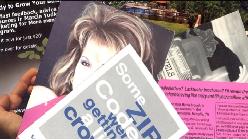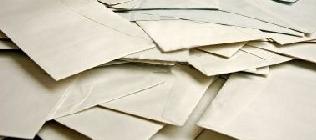Postcard Marketing: Three Case Studies
by Marcia Yudkin
Postcard Marketing by a Local Printer
Here's an incredibly simple
system a smart local printing company uses month
after month after month to get new customers
into its shop to place an order.
Like all successful postcard
marketing campaigns, it started with strategic
thinking: What category of people could serve as
a reliable source of new customers? The owner's
answer: new business incorporation's within a
10-mile radius of his print shop.
A list company provides him
once a month with a data file of prospects that
meet that description.
Note that not all new
incorporation's are brand-new businesses, but
because of the incorporation, they now have a
new business designation, "Inc.," to add after
their name. So whether or not they're a new
business, they're a perfect prospect for
printing services since they have a new business
name they want to get out into the world.
Next, what offer would
entice them into the shop? The owner's
answer: a bundled offering of printed
stationery, envelopes and business cards at
40% off.
Using the online interface at
PostcardBuilder.com or another online
print-and-mail company, he designs a postcard
containing that offer. To get the discount, the
recipient needs to bring the postcard into the
shop with them.
Once a month, his assistant
uploads the new list of newly incorporated
businesses to the print-and-mail company,
presses a few buttons, and that's it. Two
business days later, that month's postcards go
out in the mail, and a few days later, owners of
the nearby newly incorporated businesses begin
showing up at his shop to use the discount.
After it's all set up, the
process takes less than 20 minutes a month to
manage.
Results are predictable.
To adjust the results, the
print shop owner can change the geographical
radius, reduce or raise the number of postcards
he sends - or schedule his mailings once a week
or every other week instead of monthly.
|
Get a Quick,
Wide-Ranging Overview of the Power of
Postcards
"Marcia Yudkin's Top Ten Strategies for Using Postcards to Market Your Business
outlines a fresh, can't-miss case for using good old-fashioned direct mail to attract new clients. Besides telling the 'why' of postcard marketing, she provides plenty of 'how-to' as well. After reading her report, I'm using Strategy #9 for my own business and Strategy #6 for one of my clients." - Jan O'Daniel, Award-Winning Copywriter, GetGreatCopy.com.
Postcard
marketing models report. |
Postcard Marketing to Speaker's Bureaus
Here's a postcard campaign
that was profitable for me some years back.
To get more speaking
engagements, I wanted to be represented by more
speakers bureaus. However, bureaus were
inundated with information kits and phone calls
from wannabes.
Therefore, I decided to offer
to help bureaus market themselves better. This
would cut through the clutter, and I'd come to
their attention as a marketing expert and a
speaker on marketing, in a back-handed way.
I obtained a mailing list of
directors of speakers bureaus and created a
postcard containing one of my Marketing Minute
newsletters. Besides the complete text of my
180-word Marketing Minute, the card invited them
to subscribe to get tips on growing their
business from my no-cost weekly email
newsletter.
Six times in one year, I
mailed a card like this to the speakers bureau
directors. The card was the same each time
except that it contained the text of a different
Marketing Minute.
|
Learn From the
Masters of No-Hype Copywriting
In 2013 and 2014, Marcia Yudkin
convened the most articulate and
experienced practitioners of no-hype
copywriting for an exchange of ideas
on writing copy that persuades
without excessive showmanship or
stretching the truth.
Presenters included Peter Bowerman,
Nick Usborne, Shel Horowitz, Karon
Thackston and others.
Order the
recordings from this telesummit. |
When I did this campaign, it
was before the advent of online postcard
marketing companies. I changed the master file
in my computer, took a printout of the card
contents to my local Kinko's, they printed up
the cards on card stock that they cut into
quarters, I stuck on the bureau mailing labels
and stamps, and finally dropped them at the post
office.
Today, the process is much
simpler. You can design a postcard template
online, cut and paste new content into it for
each new mailing, upload the data file for the
postcard recipients just once, and have
PostcardBuilder.com or another online postcard
print-and-mail company print and send the cards
for you. There's no need to touch or mess with
mailing labels, stamps or even the postcards.
Just place the order and it's done.
And my results? One bureau
owner hired me for copywriting from the first
mailing and lined up a speaking engagement for
me a year later. Three other bureau owners I
mailed to added me to their roster, with two
additional bookings coming out of that. Several
other bureau owners joined my Marketing Minute
list and purchased products or services from me
years later, or referred others who did so.
Financially, the campaign
brought me at least fifteen times as much in
revenues as I spent, with results trickling in
for more than seven years.
And I didn't make a single
cold call to a bureau owner, which for me was an
unspeakably big plus!
Postcard Marketing Recession Rescue
Someone asked me if
postcards are a good marketing tool for a
recession. Yes, they are! Indeed, postcards
pulled me out of the 1990-91 recession.
With a business partner,
I'd started a training company in writing
skills and rented an office at the
prestigious Statler Office Building,
adjacent to the Park Plaza Hotel in Boston.
As the recession deepened, companies froze
their training budgets, and all of our hot
training leads evaporated.
However, I had two
significant assets to exploit. First, our
office rent included access to a classy
conference room we could reserve as much as
we wanted, and second, I had a list of 3,000
people who'd been in one of my adult
education classes on writing in the previous
two years.
I wrote up three classes
we could give in the conference room,
reserved the dates and mailed postcards to
my list. People called to sign up! For the
next few years, until the economy recovered,
postcards reliably filled our classes.
Several lessons I learned
about postcard marketing during those years
remain true today.
1) Responses from a "warm"
list of people who know you will always be
greater than responses from strangers. Our
classes were $99 each, and I'm not sure the
postcards would have yielded such a nice
profit had they been sent to "cold"
prospects.
2) For seminars, you need
sizable mailings to get enough participants
to fill the room. The response rate would
have been the same had I sent just 1,000
postcards, but that might not have generated
enough people for each class.
3) Consistency and
repetition help. I mailed postcards every
two months for a new round of classes,
always using magenta card stock from the
Kinko's copy center. From what people said
when they signed up, it was clear they had
come to recognize the hot pink postcards as
coming from me. People paid more attention
to the postcards as time went on, not less.
4) Color attracts, but
images are optional. I used boldface
strategically on the postcards to create a
readable layout, but the cards contained no
images - only words. If you look at
galleries of sample postcards online, you'll
see no pure-text samples, but for certain
purposes they can work extremely well.
One thing that's changed
since postcards pulled me out of that
recession is that you no longer have to mess
with address labels and stamps or postal
permits to send postcards. Choose the right
postcard vendor, and you can design your
postcard online, upload your database and
order the cards sent on a specific date.
It's so much easier now.
Copyright 2013 Marcia Yudkin.
All rights reserved.
 |
Learn to Write
No-Hype Copy
Six-week self-study course teaches
you to wow people into buying through
the power of well-chosen words.
Includes challenging and varied
assignments to practice on, with answers
from the instructor and participants.
Replace incomprehensible jargon with
reader-friendly, motivating content.
Copywriting course. |
|







